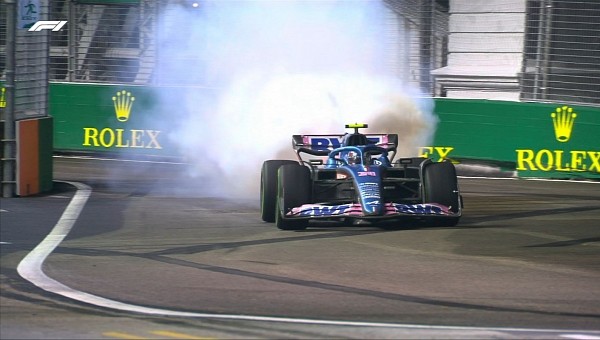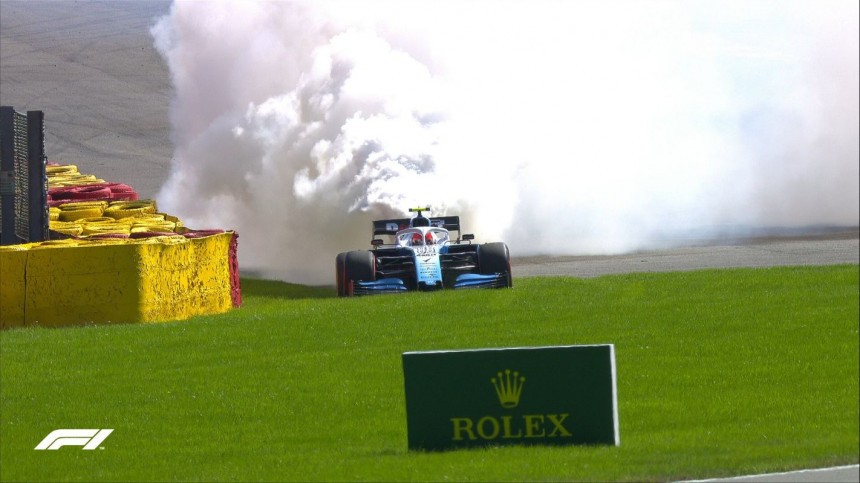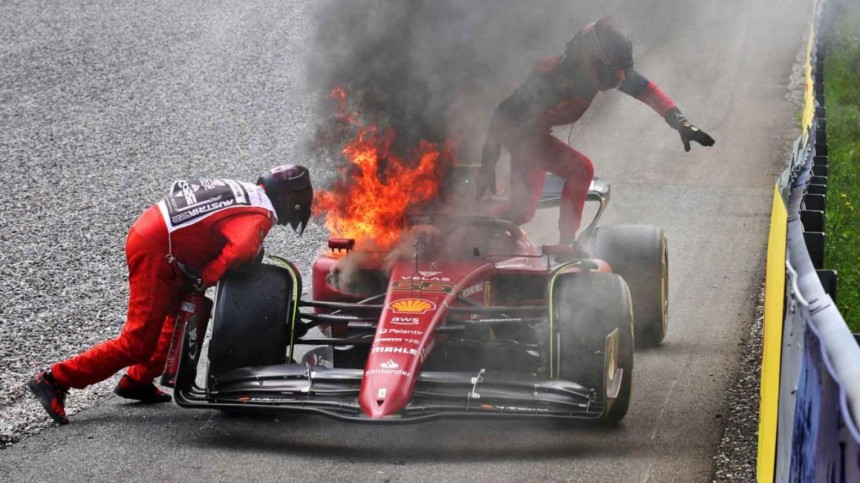Formula 1 engines are the most advanced and complex power units you can find anywhere in the automotive industry, or maybe in any industry. But even those can go bang occasionally, and today we will find out why.
Basically, there are a lot of reasons why an engine explodes and catches fire, but there are several main factors. I will explain everything about the most common three reasons, and how you can spot the factors leading to the explosion in a live race so you can show off in front of all your friends. In this piece we will only focus on the mechanical stuff of the combustion engine, because F1 engines are so insanely complex that hundreds, if not thousands, of different components could fail at any moment.
However, I promised to stick to the simple stuff, the three most common areas of failure. Those would be the top end, bottom end, and turbo failures. In the top end of the engine, the most common things to fail are the pistons, gaskets, valves, and the head, while at the bottom of the power unit, we have parts like the crankshaft, rods, bearings, and the crankcase. And almost every piece has its own identity, so you can most of the time recognize the failure by the noise it makes or by the smoke coming out the back of the power unit.
Usually, things fail because of overheating, vibration, lubrication issues, and excessive load, among others. At the same time, Formula 1 engines are so complex that if one thing strays away from that perfect balance, the rest of the parts will follow quickly. Road vehicles are tuned for reliability, so if the power unit sometimes overheats or runs a bit lower on oil, it's usually alright. However, F1 engines aren't designed for day-to-day activity. They are purely about maximum power and performance during the races they are created for.
The biggest and perhaps the rarest failure is a bottom-end malfunction of the power unit. Because so many things are connected down there, it tends to be catastrophic when something fails. Besides, most of the time, there is something wrong with the crank or bearings, and from that point, everything connected wants to stop and seize up. When that happens, everything erupts out of the crankcase. It's the typical kind of failure you see when looking at a race.
A bottom-end failure won't create lots of white plumes of smoke at the back of the engine. But it tends to release lots of oil and flames creating this very dirty smoke which comes at a low level out of the back, in the cooling exits zone. Most of the time, this can quite quickly turn into a fire as well. This usually fast and catastrophic failure is most of the time caused by the crankshaft rods and bearings.
Moving on to top-end failures, these can be different too. It's here where we get parts like the pistons, valves, and the valve return system. The top end of the power unit also includes the interface between the head and the cylinder block. This would consist of the head gasket in a road car, but because Formula 1 components are so precisely machined, they often only use an O-ring. You can recognize this failure by a massive plume of smoke coming out the back of the car, billowing white clouds from the exhaust or the engine cover when one of the cylinder heads broke out. This is a fancier and more spectacular failure than the bottom-end one. As a result, the driver will immediately lose all power.
The final most common failure is the turbo. Turbos are going extremely fast in Formula 1, and for them to do that, they need to have perfect lubrication and perfect bearings to keep that all working. If anything should break down, then you have a slightly different sort of failure than we've seen with the top end or the bottom end, because a turbocharger can fail either quite slowly or fail immediately.
When the turbo fails, it tends to be because of an issue with the lubrication in the bearings. For example, the turbocharger wants to stop meaning the impellers are impacting the casings. As a result, parts start to explode and fly out of the cases. Typically this means there is a huge loss of oil almost immediately as you get this vast catastrophic failure. If you happen to be on board, you will actually hear the noise of the turbocharger. That whistling suddenly drop. From the outside, watching on TV, you will start seeing those puffs of blue smoke coming out of the tail of the exhaust pipe. Still, it's not like the top-end failure where you will get billowing smoke.
Those were the most common reasons why Formula 1 engines explode and why you see those big puffs of smoke and massive fires. From now on, you will be able to tell what type of failure it is.
However, I promised to stick to the simple stuff, the three most common areas of failure. Those would be the top end, bottom end, and turbo failures. In the top end of the engine, the most common things to fail are the pistons, gaskets, valves, and the head, while at the bottom of the power unit, we have parts like the crankshaft, rods, bearings, and the crankcase. And almost every piece has its own identity, so you can most of the time recognize the failure by the noise it makes or by the smoke coming out the back of the power unit.
Usually, things fail because of overheating, vibration, lubrication issues, and excessive load, among others. At the same time, Formula 1 engines are so complex that if one thing strays away from that perfect balance, the rest of the parts will follow quickly. Road vehicles are tuned for reliability, so if the power unit sometimes overheats or runs a bit lower on oil, it's usually alright. However, F1 engines aren't designed for day-to-day activity. They are purely about maximum power and performance during the races they are created for.
The biggest and perhaps the rarest failure is a bottom-end malfunction of the power unit. Because so many things are connected down there, it tends to be catastrophic when something fails. Besides, most of the time, there is something wrong with the crank or bearings, and from that point, everything connected wants to stop and seize up. When that happens, everything erupts out of the crankcase. It's the typical kind of failure you see when looking at a race.
Moving on to top-end failures, these can be different too. It's here where we get parts like the pistons, valves, and the valve return system. The top end of the power unit also includes the interface between the head and the cylinder block. This would consist of the head gasket in a road car, but because Formula 1 components are so precisely machined, they often only use an O-ring. You can recognize this failure by a massive plume of smoke coming out the back of the car, billowing white clouds from the exhaust or the engine cover when one of the cylinder heads broke out. This is a fancier and more spectacular failure than the bottom-end one. As a result, the driver will immediately lose all power.
The final most common failure is the turbo. Turbos are going extremely fast in Formula 1, and for them to do that, they need to have perfect lubrication and perfect bearings to keep that all working. If anything should break down, then you have a slightly different sort of failure than we've seen with the top end or the bottom end, because a turbocharger can fail either quite slowly or fail immediately.
Those were the most common reasons why Formula 1 engines explode and why you see those big puffs of smoke and massive fires. From now on, you will be able to tell what type of failure it is.












